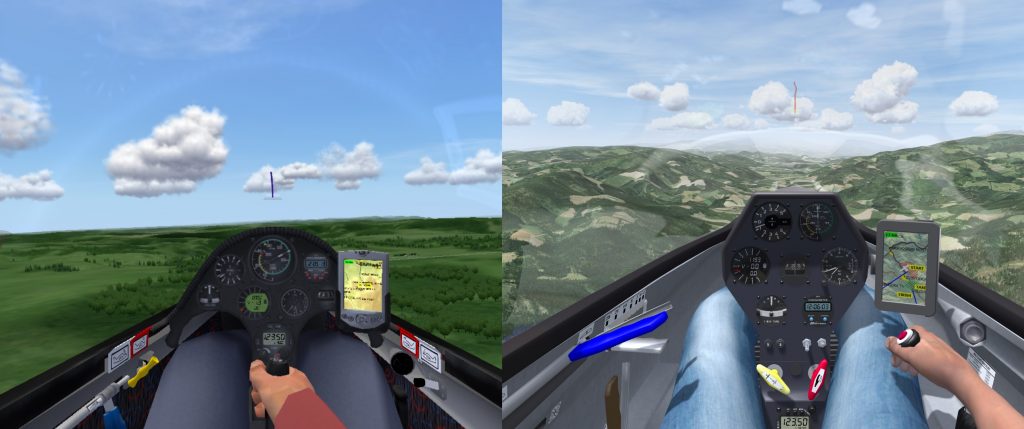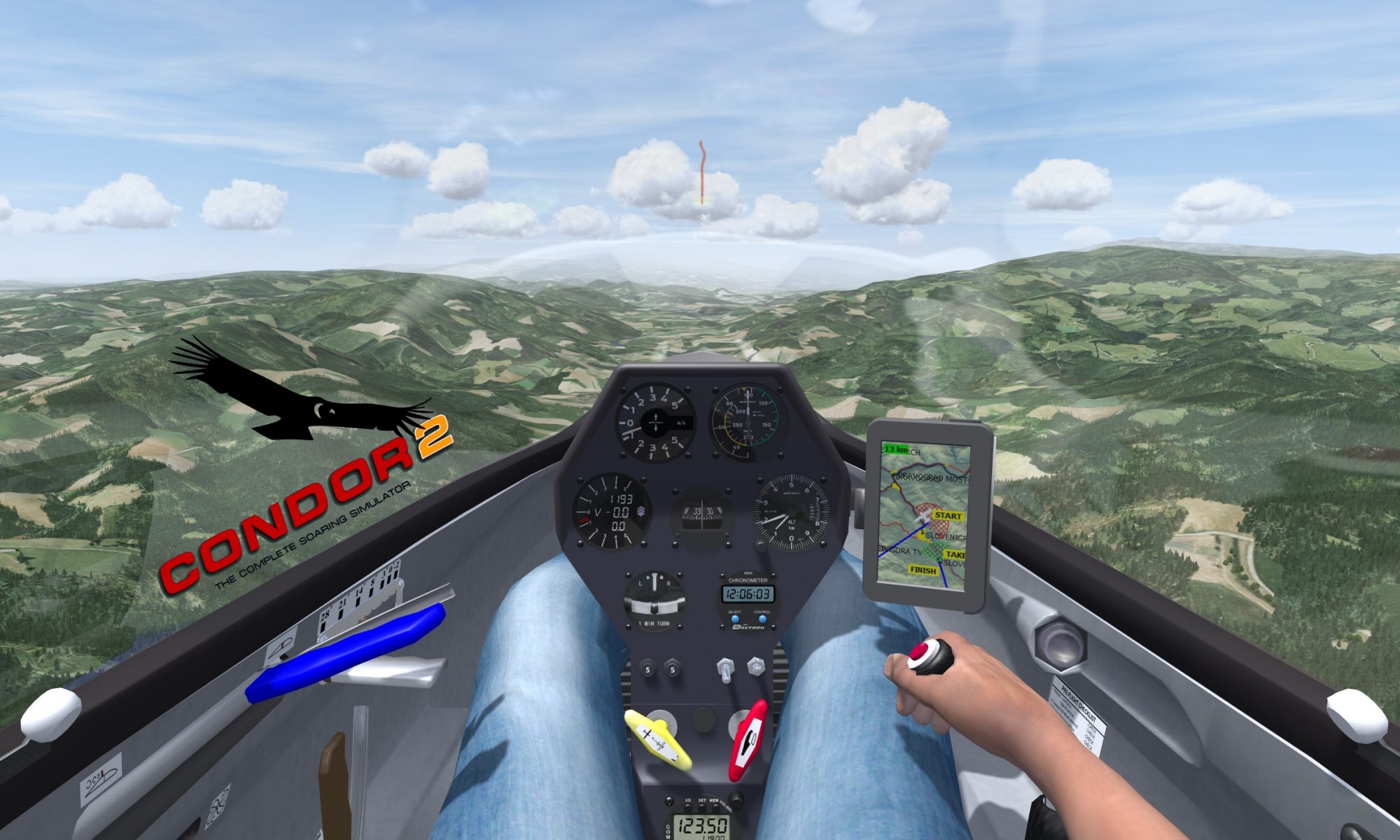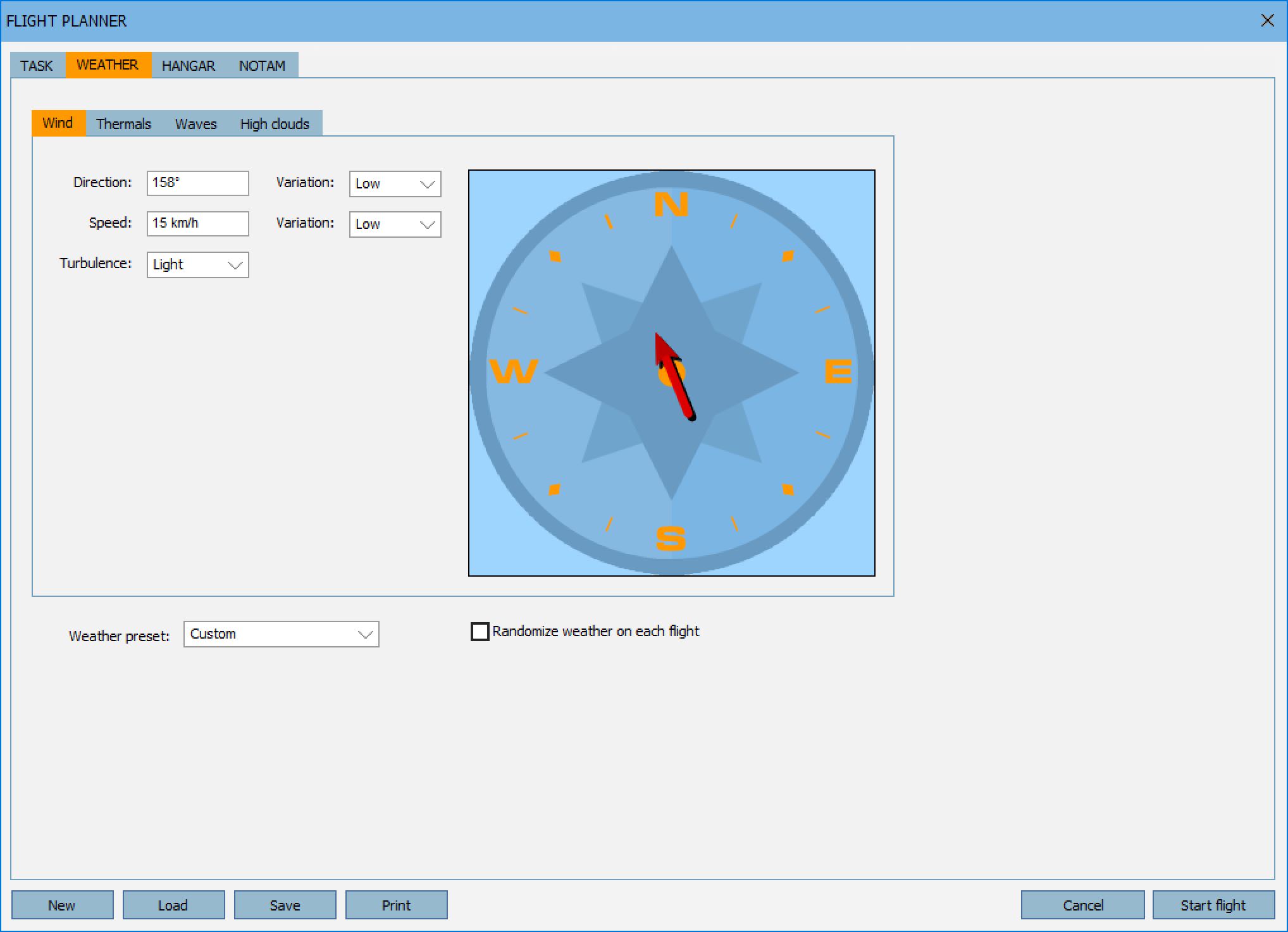I told you I was going to actually review Condor 2 (Homepage) at some point, just give it some time. And here it finally is. I present to you, in a more or less readable form, my thoughts on Condor 2. Enjoy!
Foreword
Over the last few months I've noticed most of my traffic was coming search queries like "Condor 2 review". My other post about it being released shows up right on top of the Google results when you search it - I think I really owe some of you guys a proper review.
Starting Out: Buying and Downloading
I could go on some time about how annoying everything surrounding the purchasing process is. Dollar pricing is way higher than Euro, while EU countries have hilarious sales tax added to the purchase. Long story short: If you're buying from within the US, go ahead and select Euro as your currency, PayPal conversion rates are cheaper than this. I had my license bought for me by Cody (thanks mate!) which saved me 5 bucks. Deal with it!
You get a download link and license, the former of which is valid for a measly 14 days. An extension to 2 years costs 6.99€? Noooo thanks! For that price I can get three USB sticks to back up the 630MB installer, deposit each at a safe spot, and I still have space left over on each of them for my testimony or whatever. Additionally, the download speed was capped at around 410KB/s, which is awful for a service they want me to pay for.

Once finally downloaded the install went pretty quick. Within a minute or two the installer unpacked an impressive 5.5GB of data, 4.9GB of which are just textures for the scenery, and I was ready to fly.
Running it for the First Time
On first launch, it will prompt you to create a new pilot's profile. This is how you'll show up in online competitions.

Afterwards you will have to click "Activate" and enter your serial number, which is displayed after purchase and sent to you as an email with your purchase confirmation. I still somehow missed both of these at first and was a bit confused. Once the online activation is done, you can quickly go through the settings and map your controls. This will only take a few minutes; gliders don't possess many buttons, therefore the list is a lot shorter than other flight sims' or - shudder - Elite Dangerous' button mapping page.

Main Menu
The menu overall is essentially still the same as Condor 1, but the design and colors have been tuned to look more like Windows 10. You have a choice between Free Flight, Lessons, and Multiplayer.

Flight Lessons
The 18 available flight lessons teach basic concepts of glider flying, divided in several categories: Basic, Intermediate, Advanced, and Acro. These focus mostly on specialties of gliding; you learn about towing, ridge lift, thermal circling, and wave flying, but even add some basic aerobatics. Each lesson can be viewed as a replay and flown manually - recommended in this order.

Free Flight
Free flight lets you set up a competition task (also known as "flight plan") in any plane at any time. Per default you only have Slovenia available, but there are already a bunch of free sceneries out there. You can get many of them at condor-club.eu for example.

Weather
Unfortunately there is no real-life weather option, but you can go nuts with the weather editor and configure the conditions in a detailed yet simple fashion. Several presets ranging from poor and turbulent to bombastic are also available. The weather can't change dynamically over time, which would have been nice. There is no precipitation in Condor 2, but you usually don't fly in rain anyway.
Hangar
Next up is the hangar. You have seven planes available in the base simulation and can currently buy another four as addons from condorsoaring.com. The screen shows a preview of the (beautifully modeled) plane and data like wing span, weight, and speed.

Other Options
Finally all that's left is to choose between aerotow, winch launch, or simply starting in the air (boo!), and you're ready to take off! Some miscellaneous settings are also available here.

Multiplayer
I did not fiddle much with multiplayer since I have no gliding friends, but the setup is essentially the same. You can either connect to an already running server, or even set up your own. This will require ports to be open etc. so it might be a hassle to get running. Nothing a seasoned flight simmer isn't used to, however.
Multiplayer allows up to 64 pilots in one session, which is pretty impressive, and supports both LAN and Internet play at the same time.
A First Look at the Simulation
Of course I wouldn't want to wait any longer. How does it look? How does it feel?
I took the Schempp-Hirth Duo Discus XL for a spin, which is part of the base game, as it's pretty close to the Schempp-Hirth Arcus I have flown in real life a few years ago. First impression summarized in one word: Awesome!
A little nitpicking upfront: I'm pretty sure the towplane causes no wake, and your movements don't move the towplane's tail. X-Plane Glider on iOS many years back did a really good job of simulating this, especially the latter. I do miss it in Condor, but I digress. It's not about crashing towplanes, and while it would add some dynamics to take into account on takeoff, it's only a minor detail.

Once we call in the towplane, it rolls up in front of us and takes off. It tows us towards the start objective set in our flight plan, or "race task" as it's called in Condor. Once we've reached the designated altitude the towplane waves it's wings, signaling us to release the rope. Towplane turns left, glider turns right, and we're off on our own.
Comparing DX11 Graphics to the Predecessor
Condor 2 is powered by DirectX 11. Quite the step up from Condor 1's old DirectX 8 engine. And it shows, as you will see.
Looking at Condor 2 on it's own at first, the graphics didn't seem mind blowing. Don't get me wrong, they're good and very nice to look at, but at first I wasn't sure if it was even really that much better than the original Condor, which I didn't touch in a while now.

Well, the moment I compared the two, I very quickly realized that yes, it does indeed look that much better than C1. Just see for yourself:


Ground textures are crisp, especially once you're a little higher up. The overall color scheme has been vastly improved and it looks quite believable. This is complimented by lots of smaller details, like cloud and cockpit shadows, higher terrain mesh and texture resolution, and the overall better DX11 visuals. Cockpits look good, only a few almost untextured looking parts stick out, like the blue airbrake lever in the picture above.
Bonus: Condor 2 finally supports multiple screens, ultrawide, 4k (and higher) resolutions, you name it. The new graphics engine alone truly makes it a product that feels like a 2018 simulator. I am very glad it's now up to speed in this department! Even on a mediocre PC Condor 2 will run 1080p at 60fps on higher settings without issues. Say goodbye to "barely getting 30fps" to which you might be used coming from P3D or FSX. Even the Microsoft Surface Pro with integrated Intel Graphics runs Condor 2 just fine on medium to high settings. Go figure.
Among the very first things I noticed was actually a rather small detail: The new yawstring looks awesome. Here's a comparison of Condor (left) and Condor 2:
So smooth! Cool. I could stare at it all day long!
Flight Dynamics
The primary and most prominently advertised features of both Condor installments are the glider physics. Are they still good? Definitely! They range from believable to very accurate as far as I can tell.
I will continue to talk the Duo Discus XL here. The plane feels appropriately heavy, just as a two-seater should, but is still very nimble. The plane moves around under your (virtual) butt, wings get pulled up and down by drafts, circling in thermals moves you about and pushes you out if you don't pay attention. Ridge lift is just as reliable as it is in real life (which saved me from going down in no man's land more than a few times) and overall it's a very enjoyable flight model.
Winds and turbulence buffet the plane, so it doesn't just fly straight like it's on rails. What I learned in real life stays true here: It will straighten itself out, often no input is needed. Gaining altitude is pretty easy in good weather, but it will require skill in not-so-great conditions. Flight controls are responsive and feel great, and oh boy is the wingflex ever so sexy!

All in all the physics of Condor 2 feel perfect for gliders. It doesn't suffer from oddities you sometimes run into in FSX/P3D or X-Plane; the gliders behave predictable and realistic at all times.
In the Cockpit

The glider cockpits are designed very well and all instruments are modeled to perfection. The variometer behaves and even beeps realistically! Needles don't bounce or suddenly change position as they might do in other simulations. The PDA available in most planes is the same as in Condor. It is very basic but has all the important features you need: Moving map, circling/lift, MC (McCready), and navigation modes are all on board.
Sound Design
The sounds of Condor 2 are spot on. They're very close to what you'll hear in a real glider. You can really judge your speed (or slip angle) from the noise the air around you makes. Deploying the airbrakes makes this very distinct and satisfying clunk! sound. I love it! When pulling the stick the wings will squeak behind you as they flex, which is actually a quite scary sound when flying a real glider for the first time. It's all there, it all sounds great - awesome job.
Check it out Yourself!
I recorded the default Condor 2 task over Slovenia in the Duo Discus XL. It's rather long and unedited, but you can scrub through it to hear the different sounds and have a look at the visuals and physics during the flight. Just a quick reminder that I am quite rusty, so it might be a bit suboptimal at times - but I execute a decent looping at 1:21:00, so check that out at least ;-)
Condor 2 - Is it Actually "The Complete Soaring Simulator"?
When I hear "complete", I think of something that is done and final. Looking at Condor 2, I must say we're probably not quite there yet. It comes with 7 airplanes and a single scenery. The latter is rather big, at approximately 218km by 150km it boasts a flyable area of 32 700km² (9 533 NM² or 12 625 Mi²). This will take a while to cross in your glider. But for variety you have to rely heavily on third party scenery. While there are some great ones, gliding does not have the huge community that general flight simulation does; you might not find your home airfield for example.
Gliders are very detailed, but there's not a huge amount of variety. No powered gliders are available, and third party airplane addons are nonexistent as the developers only allow their own. Their goal is to provide the best competition experience, so I understand why: With the focus on competition it's important to have accurate planes and prevent "cheating" by using badly modeled planes. Unfortunately this also closed the door on the small but dedicated Condor community to create a vast amount of beautiful gliders, flown for fun and enjoyment by someone who's a little more casual about it, like myself.
The Verdict
Ultimately this is the best simulation for gliding you can get out there, hands down. All other simulators get some things right and others disappointingly wrong. Condor 2 however will not disappoint where others fail: The physics simulation is solid, sounds are close to the real deal, and planes behave the way they should and feel superb.
9/10. The physics rock, the visuals rock, the sound design rocks. Only the variety lacks a little bit, but overall it just ROCKS! - Mazzn
Update (May 20, 2019): As mentioned by Chris in the comments below, Condor 2 was updated with native VR support a while back - around Christmas 2018 - which is awesome! While I have not had the time to properly try it yet, virtual reality is a huge step in the right direction, both for glider simulation and flight sim in general. Condor 2 in VR means the best gliding experience meets the best immersion, and just might nudge my rating towards a 10/10, depending on how well it's implemented. I certainly plan on revisiting Condor 2 with an exclusive VR review, like I did with Aerofly FS 2. so keep an eye out for that!
Got something to say? Leave a comment! I'm still inexperienced with all this article writing and I'm open to any suggestions. Thank you for reading all of this, I appreciate you taking your time. If I sparked your interest, make sure to check out some of my posts, I wrote about switching over to Prepar3D from FSX, reviewed Aerofly FS 2, and took a look at the VRS F/A-18E Superbug for FSX and P3D!






We like your review. I hope you saw that Condor supports VR since Christmas 2018?
Maybe you could add that to your review?
Hi, thank you for your comment! Happy to hear you like what I wrote. I did see the VR update, but unfortunately have been lacking the time to actually try it out. I’ll add a short update to the post and try to make room in my schedule for a more in-depth look at it :)
Thanks for reviewing it!
I have Condor 1, and have not upgraded yet to Condor 2 because I can’t decide whether it is worth the money.
From your review, I’d have to say “probably not, except maybe to get VR support”.
Does that sound about right?
Hey Johan, thanks for checking out my review!
Upgrading to Condor 2 was worth it to me, mostly due to the new graphics engine which looks much, much better. It improved my immersion quite a bit and supports higher display resolutions, which was a problem for me when flying the original Condor with a triple screen setup. I couldn’t go back after seeing how much prettier Condor 2 is. It also handles large scenery add-ons much better (less crash-prone). I also ended up paying 8€ for the ASK 21 add-on plane, which was my training glider in real life, and even though I don’t have much time to fly it these days I don’t regret spending my money on it.
Long story short, I would recommend upgrading to Condor 2 if you can spare the cash for it.
Great review, entirely consistent with what a friend showed me today.
Thanks
What is the difference for nthe higher priced “PRO” version?